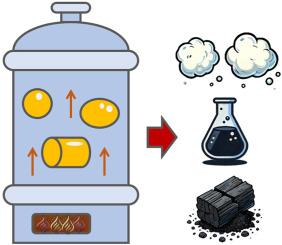Influence of pellet geometry within the thermal degradation process of biomass: Computational model of a fluidized bed reactor
IF 4.3
2区 材料科学
Q2 ENGINEERING, CHEMICAL
引用次数: 0
Abstract
The influence of pellet geometry on the biomass pyrolysis process within a fluidized bed reactor is analyzed. Using a computational model based on the Core Shrinking Model (CSM), the effects of pellet size, density and geometry (spherical, cylindrical and ellipsoidal) on heat and mass transfer, as well as on the thermal degradation efficiency, were investigated. The results indicate that cylindrical and ellipsoidal geometries have better efficiency in heat and mass transfer compared to spherical geometry, due to their greater surface-to-volume ratio. Furthermore, it was observed that pellets with smaller equivalent particle diameters decompose more quickly due to their higher heat transfer efficiency. However, the study also reveals that the formation of pellets with specific geometries has a limited impact on the formation of a particular product. These findings have significant implications for the optimization of reactor design and selection of pellet geometries to improve the efficiency of biomass pyrolysis processes.

生物质热降解过程中颗粒几何形状的影响:流化床反应器的计算模型
分析了颗粒几何形状对流化床生物质热解过程的影响。采用基于核心收缩模型(CSM)的计算模型,研究了颗粒尺寸、密度和几何形状(球形、圆柱形和椭球形)对传热传质和热降解效率的影响。结果表明,与球形结构相比,圆柱形和椭球形结构具有更好的传热传质效率,因为它们具有更大的面体积比。此外,等效粒径越小的颗粒传热效率越高,分解速度越快。然而,该研究还表明,具有特定几何形状的颗粒的形成对特定产品的形成影响有限。这些发现对于优化反应器设计和颗粒几何形状的选择以提高生物质热解过程的效率具有重要意义。
本文章由计算机程序翻译,如有差异,请以英文原文为准。
求助全文
约1分钟内获得全文
求助全文
来源期刊

Particuology
工程技术-材料科学:综合
CiteScore
6.70
自引率
2.90%
发文量
1730
审稿时长
32 days
期刊介绍:
The word ‘particuology’ was coined to parallel the discipline for the science and technology of particles.
Particuology is an interdisciplinary journal that publishes frontier research articles and critical reviews on the discovery, formulation and engineering of particulate materials, processes and systems. It especially welcomes contributions utilising advanced theoretical, modelling and measurement methods to enable the discovery and creation of new particulate materials, and the manufacturing of functional particulate-based products, such as sensors.
Papers are handled by Thematic Editors who oversee contributions from specific subject fields. These fields are classified into: Particle Synthesis and Modification; Particle Characterization and Measurement; Granular Systems and Bulk Solids Technology; Fluidization and Particle-Fluid Systems; Aerosols; and Applications of Particle Technology.
Key topics concerning the creation and processing of particulates include:
-Modelling and simulation of particle formation, collective behaviour of particles and systems for particle production over a broad spectrum of length scales
-Mining of experimental data for particle synthesis and surface properties to facilitate the creation of new materials and processes
-Particle design and preparation including controlled response and sensing functionalities in formation, delivery systems and biological systems, etc.
-Experimental and computational methods for visualization and analysis of particulate system.
These topics are broadly relevant to the production of materials, pharmaceuticals and food, and to the conversion of energy resources to fuels and protection of the environment.
 求助内容:
求助内容: 应助结果提醒方式:
应助结果提醒方式:


